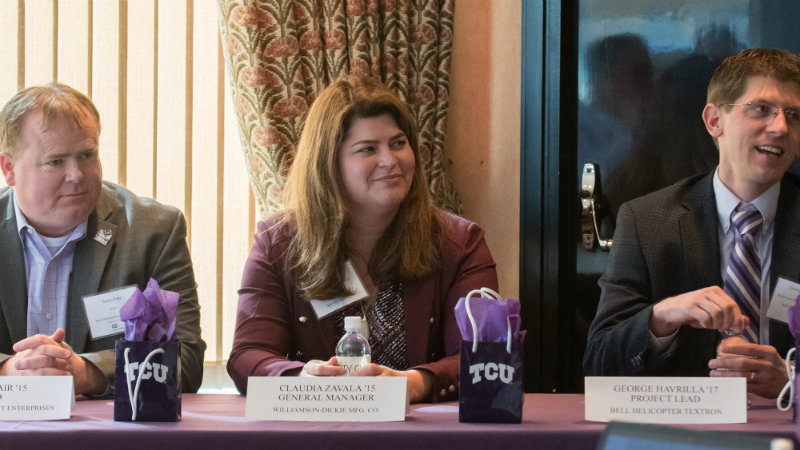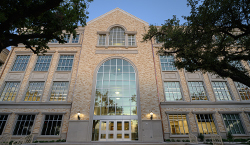Every preview luncheon features a panel of alumni who offer their personal insight into the benefits, challenges and experience of the TCU Neeley Executive MBA program. Here are some of our favorite soundbites from the January 24 luncheon.
March 05, 2018
Every preview luncheon features a panel of alumni who offer their personal insight into the benefits, challenges and experience of the TCU Neeley Executive MBA program. Here are some of our favorite soundbites from the January 24 luncheon.
The Panel
George Havrilla, ‘17
Project Lead, Strategic Transitions Group, Bell Helicopter
George’s background is in the very technical area of mechanical engineering. After 15 years at Bell, the Executive MBA program was his opportunity to broaden his perspective.
Claudia Zavala, ‘15
General Manager of Product Development, Williamson-Dickie Mfg. Co.
Claudia was very left-brain focused at Williamson-Dickie, and entered the EMBA program to gain more right-brain leadership skills.
Jamie “Opie” Fair, ‘15
COO, Agile Management Enterprises
Opie was laid off mid-program, but his new skills allowed him to start a successful merger and acquisition company with some of his classmates.

HOW HAVE YOU PERSONALLY DEVELOPED AS A LEADER?
GEORGE
After this 18-month program, the coaching, the agile leader model, I came out with greater confidence. Now I’m seeing opportunities within Bell thinking, “I can do that.” Before, my skills were sort of limited and narrow. But now I have a greater degree of self-awareness and self-confidence.
CLAUDIA
It’s a process. One day in the program, things just start clicking; people see you a different way. They ask you “what’s changed?” You learn how to really work with your teammates. Someone’s strength may be your weakness, but it can become your strength when you learn from them. And you learn to bring that leadership not just to your workplace but to your family.
OPIE
In the beginning, you do a 360 survey with your supervisors, peers and subordinates. It helps you recognize skill sets you didn’t realize you had, maybe you even thought were weaknesses. Then your team and coach help you develop your strengths and improve your weaknesses. You do a follow up survey with your teams after every rotation. Self-awareness and knowing where I sit personally has helped a lot.
HOW HAS THE PROGRAM’S TEAM FOCUS HELPED YOU CONNECT?
CLAUDIA
So much comes from the diversity in the group. I’ve had 20 years in apparel and I may be teamed with someone from banking. You learn to acknowledge your weaknesses and let the other person take the lead – which is hard if everyone in the group is Type A and wants to be a leader all the time. But then you start identifying the different strengths: Who can write? Who is left brain, who is right brain?
OPIE
You take the Myers-Briggs Type Indicator in the beginning – it shows you your blind spots. But combined, we had no blind spots as team. In corporate America, you’re the leader every day, but on a team, you must play the supporting role sometimes. But you’ll still lead in certain areas where you have strengths. That’s when you learn leadership by knowledge or skill set rather than leadership by position.
GEORGE
It’s three teams, and over 18 months, you’re embedded with different groups of four or five people to collaborate on assignments together. It’s like Draft Day – who am I going to be paired with? I think the faculty laughs at us behind the scenes. They look at the Myers-Briggs results and group people together specifically for diversity, like “let’s put the introverts with extroverts!” Because if you’re always working with people who think like you and act like you, you won’t learn anything.
WHAT EXAMPLES OF REAL RETURN ON INVESTMENT HAVE YOU SEEN?
OPIE
One example? I have lots. We were dealing with this one company that was a potential acquisition. While negotiating, they anchored at a price. It wasn’t a bad price, but it wasn’t ideal. We used Dr. Kosnik’s negotiation materials and the BATNA (best alternative to a negotiated agreement) to put together a two-page document showing all we would implement and why it was important, then said we’d agree to their price. Then they came back and said, “We’ll increase the price $200K just to work with you.” Other stuff I’ve learned, I use every single day.
CLAUDIA
Lots of soft skills are growing in my career since the program. People ask me how I do it. I work with executives of different levels, from supply chain to other departments. And that comes from classes like negotiation, where I learned to be tough with my team members in certain circumstances. Also there are technical aspects like the statistics program Tableau. I brought it from this program to my company, and now my company is using it in a big way.
GEORGE
Then during the fall, my oldest daughter was in the hospital sick, and I had a huge project at work. So I was in the waiting room on the phone with my boss. He asks “how much is forecasted in our finances?” And I could do a 5-year forecast on the back of a napkin because of Dr. Rodriguez’s class, and now that’s what we’re reporting to stakeholders. I was confident in those numbers because of the class.
The panel shared much more insight that we didn’t list here. Join us for the next preview luncheon and don’t miss a word.
This panel discussion followed an engaging talk by Dr. Meade on supply chain management. Read that recap here.

